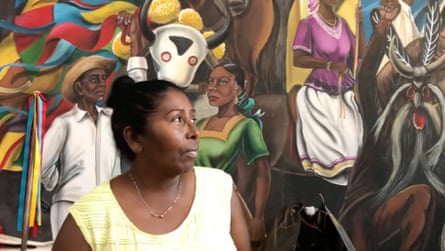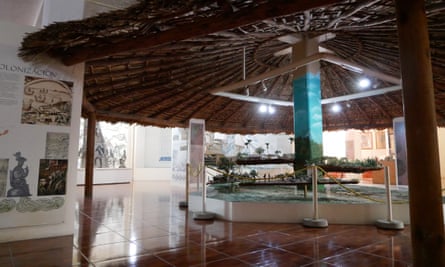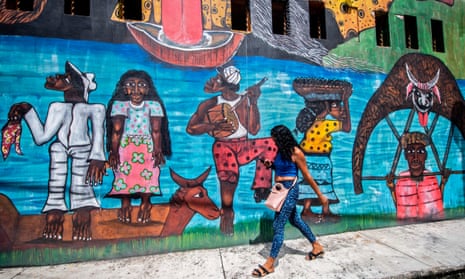Angélica Sorrosa Alvarado is the curator, manager, tour guide, administrator, caretaker and cleaner at the Museo de las Culturas Afromestizas (Museum of Afro-Mexican Culture) in Cuajinicuilapa. “I am alone,” she says, gesturing at the cavernous halls of the museum, which she describes as “one of my proudest achievements”.
In the Costa Chica region, which is home to Mexico’s largest population of African-Mexicans, the museum is unique in the country. When it opened 25 years ago, it was heralded as recognition of the more than 2.5 million Afro-Mexicans in a country that had long overlooked them.
Now, however, the museum is now facing closure. Unpaid for 15 years and deserted by the founding committee who helped her create the space in 1999, Alvarado, 62, is fearful that she will soon have to retire. “They all left and now I am old and alone here,” she says.

Inside, painstakingly detailed dioramas depict white men flogging naked black figures, enslaved people who were brought to Mexico from Africa by the Spanish conquistadors in the 16th century. Etchings show hundreds of black people labouring in silver mines and plantations, and drawings show bodies hanging from wooden gallows.
As the exhibits move through the years towards the present day, a powerful and resistant identity emerges. Brightly coloured murals show Afro-Mexican cowboys on horseback next to flamboyant masks of devil-dancers, which symbolise slave resistance. There are paintings of Vincente Guerrero, Mexico’s second president. Guerrero, who was of African descent, abolished slavery in 1829 – 36 years before the US.
“The doors to the museum must stay open because there are children growing up here who do not want to be black,” says Alvarado. “This space shows us where we came from, who we are and why we should be proud of our identity.”
A physiotherapist, Alvarado fits in enough sessions to keep herself going financially while dedicating the rest of her time to keeping the museum going. But she feels defeated. With one hand on her chest, she says she regularly struggles to breathe after sweeping the floor and cleaning the exhibits of the dust that blows in from the street. The physical work makes her “bones and muscles ache throughout the night”.
“I don’t have people supporting me in this fight,” says Alvarado. “When we opened here, we had 10 people working in paid positions and I couldn’t even imagine the museum shutting. Today, I don’t think it can stay open.”

When Andrés Manzano Añorve, then municipal president, officially opened the museum, he likened it to a “stone that says we exist, which will be remembered by visitors for 2,000 years”. In the early 2000s, Alvarado remembers feeling “seen and heard” as she welcomed visitors from Africa, the US, the UK and Germany.
After the Mexican revolution in 1910, as the country united behind a shared national identity, its varied ethnic make-up became diluted. “The participation of the Afro-descendant population is left out” of national history, the Mexican anthropologist, Gabriela Iturralde Nieto said in 2019.
For Afro-Mexicans, who today make up approximately 2% of the population, their identity was almost completely omitted from Mexico’s national history records, textbooks and travel guides.
“It was as if we didn’t exist as peoples,” says the Afro-Mexican campaigner and politician, Rosa María Castro. “This lack of recognition is what motivates us to try to not be erased from history. We want children to read about us in school.”
after newsletter promotion

Omission has had a profound systemic effect, Castro says. Afro-Mexicans say they are victims of institutional and structural racism, often stopped at police checkpoints. Discrimination in Mexican courts is regularly experienced and access to higher-paid jobs and housing opportunities are often restricted due to the colour of their skin.
“Mexico is a country that prides itself on the diversity of its peoples,” says Castro. “We are talking about 68 culturally differentiated peoples, each with its richness, language, and tradition. But no one spoke about black people.”
It was not until 2015 that Mexicans were given the opportunity to identify as Afro-Mexican in a preliminary national census. In 2019, Afro-Mexicans were formally added to Mexico’s constitution within a landmark amendment that was meant to increase public funding and improve access to healthcare in Afro-Mexican communities.
But today, many residents of Cuajinicuilapa, like Alvarado, feel the same sense of frustration and disappointment they lived with for years before the constitution’s amendment.
“We will lose this museum because soon I will no longer be able to keep it from falling into disrepair,” she says. “Then, even fewer will know the story of our people. We are still at the bottom of the ladder.”
